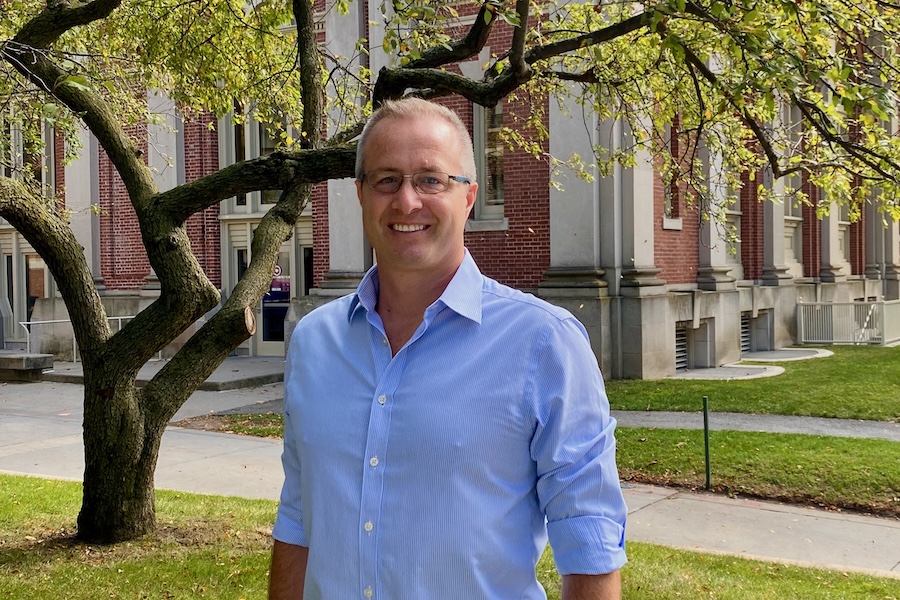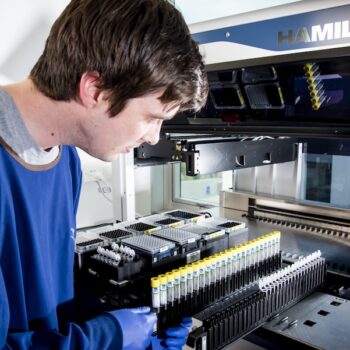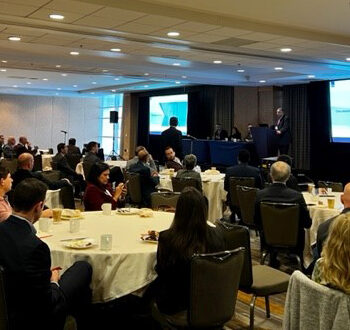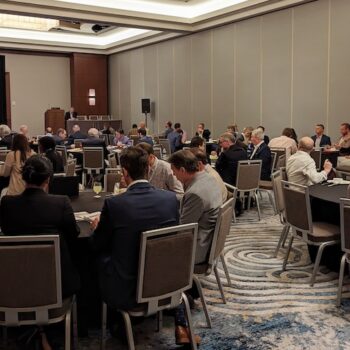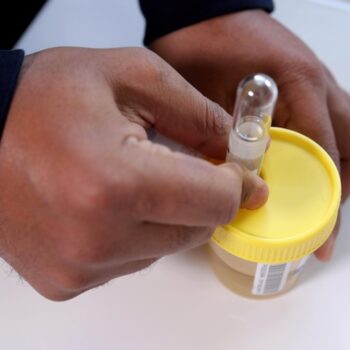Pictured above: Peter Meintjes.
After making the finals five years in a row, Pacific Edge was recently crowned the Fastest Growing Technology Business and Fastest Growing Exporter for Dunedin and the lower South Island in the prestigious Deloitte Fast 50. Its world-leading bladder cancer diagnostic and prognostic technology is catching the attention of urology clinicians worldwide.
Navigating the technology roadmap that’s necessary to commercialise and export an all-new bladder cancer diagnostic and prognostic testing procedure understandably takes time and a lot of tenacity, which Dunedin-based company Pacific Edge has in spades.
Today the Deloitte Fast 50 category winner (Fastest Growing Technology Business and Fastest Growing Exporter) is continuing to see rewards and recognition for all the years of development work on its Cxbladder* technology and is on the cusp of gaining significant traction in the North American market.
Historically Pacific Edge has been a science and technology company, but in recent times has morphed into more of a commercial business focused on achieving sales in New Zealand and the United States. This has added complexity to the business, explains Pacific Edge CEO Dr Peter Meintjes.
“The technology and science become one small component of what we need to be excellent at. We now require a science team, clinical laboratory operations, clinical evidence generation team, as well as specialists in sales, marketing, market access and reimbursement.
“So, despite being quite small in number with a headcount of just 115 people across the globe, we’ve become a high-complexity business delivering on a broad range of products.”
Dr Meintjes’s career since leaving academia has been all around the sales and marketing of disruptive innovations, and it’s his expectation that Pacific Edge will ‘own’ all of its sales and marketing channels.
“We do use distributors in Southeast Asia, who help us on things like local translation and logistics. However, we still control the messaging and lead the market presence for conferences, medical affairs education and product registration, quality and market access,” he explains.
“Rather than outsourcing or partnering for the commercial channel, if you own that last mile and the relationship with the customer, you’ve got genuine ownership of the entire value chain and subsequently maximum revenue and margins.”
Currently Pacific Edge’s clinical diagnostic technology is focused on bladder cancer, but down the track, having perfected their framework for evidence generation and commercialisation of validated diagnostics, the plan is to become excellent at identifying new unmet clinical needs in other disease areas, and “plug in” new science, technology or IP into their clinical evidence generation frame and commercialise tests in, for example, liver cancer, ovarian cancer, kidney disease, among other possibilities.
Global ambitions
Pacific Edge has the awards, the science and technology, and the products. It’s Cxbladder technology is available to roughly 75 percent of New Zealand’s population, though utilisation is still estimated at around 40 percent.
Pacific Edge would welcome a national pathway similar to what has already been achieved in New Zealand for bowel cancer screening by spreading the optimised pathway in the Canterbury system across all Te Whatu Ora regions.

Christchurch Hospital’s Outpatients Building. Cxbladder has been deployed across the region via a clinical pathway for haematuria evaluation.
“A national clinical pathway for haematuria evaluation and bladder cancer surveillance is a win-win,” says Dr Meintjes, “because more patients would receive care, and the health systems would save money by reducing the number of unnecessary cystoscopies in lower risk patients.”
Cxbladder is making haematuria evaluation and surveillance significantly more efficient for clinicians and healthcare systems, as well as improving the quality of life for patients.
In 2024 the focus has been squarely on evidence generation and global commercialisation.
“Evidence generation underpins the success of your commercialisation,” explains Dr Meintjes. “If you have good quality clinical evidence and insurers can easily evaluate that evidence for themselves in your publications, then those insurers are more likely to pay for the tests and the physicians are also more likely to order them, because they understand them.”
It’s all about encouraging behaviour change, he says, with the goal of having all that high quality clinical evidence change the clinical practice of urologists, as well as encourage insurers to pay for Cxbladder.

“It’s a major shift from our founding days when Pacific Edge was a scientific company discovering biomarkers using microarrays to have now become a US-focused oncology diagnostics company leading the market in the world’s largest healthcare market, the USA.
“This commercial success all comes off the back of generating vast quantities of high-quality clinical evidence and is a key component of the messaging for our sales and marketing teams.”
Positive US feedback
Pacific Edge has quickly built up a large number of loyal customers around its Cxbladder product with thousands of urologists having used it and hundreds using it every month.
But this is just the tip of the market. Dr Meintjes says that so far they’ve captured just one to two percent of the US health system.
“The feedback to date has been almost universally fantastic,” he says. “We are part of the urology eco-system and many of the key opinion leaders in urology are either clinical advisors to the company, principle investigators in our clinical trials, run their own investigator initiated trials with support from our Medical Affairs Team or partner on health economics and other research publications.
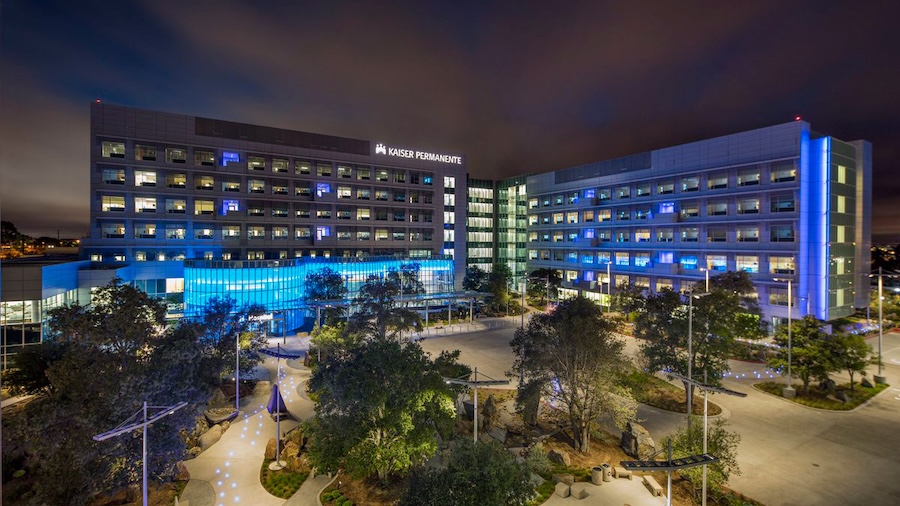
Kaiser Permanente is the largest integrated healthcare provider in the US, serving 12.6 million members. Cxbladder is in use across its Southern Californian region which covers around a third of its patients.
“Future work may involve research collaborations and clinical trials with pharmaceutical companies who might want to understand if Cxbladder can help identify if their drug would be effective, or after intervention if their drug has been effective. In partnership, we can help Cxbladder become a surrogate endpoint for their clinical trials and tell them exactly that.”
Becoming entrenched in the American urological community is the ultimate goal, says Dr Meintjes – which will be a combination of the clinical evidence and commercial success.
Medical conferences in the United States are major marketing opportunities for Dr Meintjes and his Pennsylvania-based team. The US has also become the key source of commercial revenue for the company, with roughly 90 percent of its revenue being generated there.
- Leading medical conferences like AUA and SUO provide an important opportunity to engage US clinicians.
“Right now, every dollar we have is better spent in the US, however we do have some exploratory approaches happening in Southeast Asia and Australia in an effort to diversify our revenue streams,” says Dr Meintjes.
He says a product must be IVD certified** in order to enter the highly regulated European and UK markets. However, they have more milestones to cover off before the timing will be right to tackle those markets and press ahead with a multi-pronged growth across all major markets.
Changing patterns of behaviour
To understand the task ahead, it’s important to think of Pacific Edge as a “behaviour change company with disruptive technologies”, says Dr Meintjes.
“We’re focusing on behaviour change. That’s what excites me the most. We need to change the behaviour of physicians who’re currently practicing medicine the way they were trained, while we’re saying ‘here’s another way you can practice medicine that’s better for patients, is less invasive, involves fewer procedures and is less expensive to the healthcare system. Do you want to trial this new way?”
There’s a message for patients too, he says – in particular for those who’ve had non-muscle invasive bladder cancer and are under surveillance and may be experiencing a recurrence of the disease.
“They’re currently undergoing a cystoscopy at least once a year, and in some cases as many as four times per the current standard of care. Our message to them is to ask for an annual Cxbladder test instead. When the result is negative, you won’t need that cystoscopy. When the result is positive, you should be seen by your physician.
- Cxbladder’s propriety non-invasive sampling system is easy for both patients and clinicians to use. US patients have the option of in-home sample collection for increased comfort and convenience.
“We can also change the pattern of behaviour for insurance companies and for professional associations within the urology community that establish new medical policy for reimbursement or set the guidelines by which all urologists are expected to practice.
“The key to our success rests on behaviour change and the only way to create this kind of behaviour change in the healthcare system is with tremendously compelling, overwhelming clinical evidence that your product works and being explicit about the patient population it works for and how to take appropriate action based on a positive or negative result.”
“That’s why we focus on evidence generation and how we communicate that clinical evidence to those different stakeholders through medical affairs, sales, marketing and executive functions. It needs to happen in all parts of the business, coordinated together and in unison.”
To learn more about the 2024 Deloitte Fast 50, visit www.fast50.co.nz
*With a non-invasive collection system and option of in-home sampling, the Cxbladder suite helps to optimize clinical practice workflow, safely sparing low-risk patients the discomfort, anxiety and risks of an invasive procedure, while prioritizing higher risk patients for immediate care.
** An IVD certified product is a medical device that has undergone rigorous testing and is compliant with regulations for in-vitro diagnostic (IVD) use.

